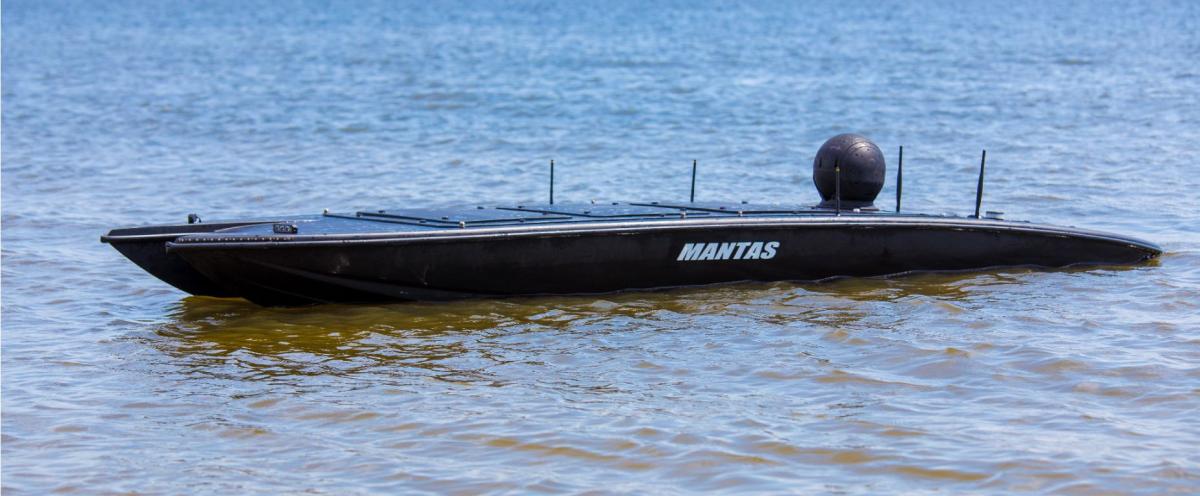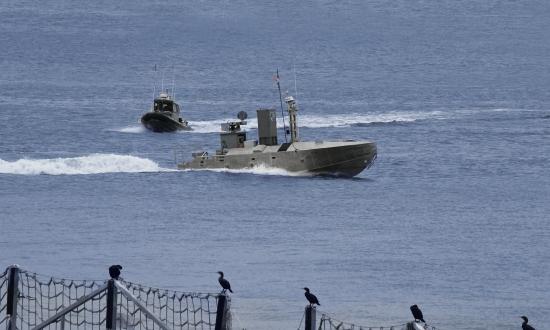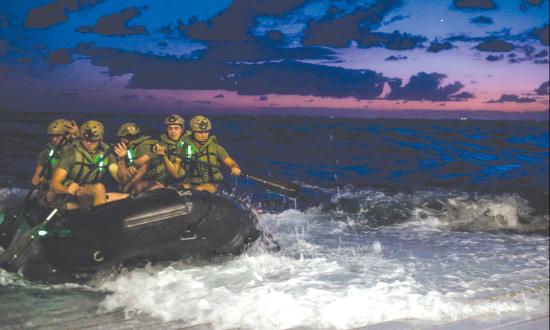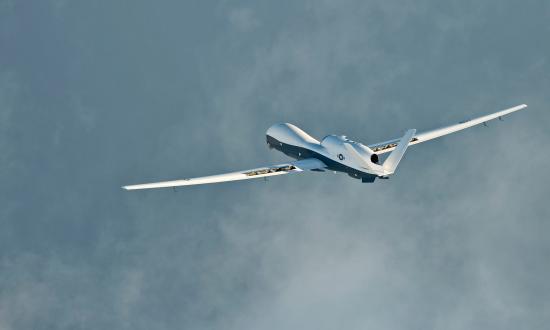A great deal of ink has been spilled regarding the military technology arms race between the United States and its peer and near-peer competitors. While opinions differ as to who currently fields the best military equipment, few would argue that the technological edge the United States once held over its potential adversaries is eroding. The Department of Defense (DoD) wants to leverage emerging and disruptive technology to ensure warfighters have an edge in combat.
When most think of such capabilities, they think of technologies such as hypersonic weapons, quantum computing, cyber, directed-energy weapons, big-data analytics, artificial intelligence, machine learning, and similar cutting-edge tools and systems. These are important technologies that can potentially lead to war-winning breakthroughs and ensure that the United States achieves battlefield dominance.
While continued maturation of these technologies—some of which are still in the early stages of development—is important to meet tomorrow’s threat, the military would be well-served to also focus on disruptive ways to combine emerging technologies to meet today’s—and tomorrow’s—compelling dangers. For example, one vexing military peril that has eluded an effective solution for decades is the hazard posed by adversary sea mines. This threat cries out for an effective technology solution.
Sea Mines: An Adversary’s Disruptive, Asymmetric Advantage
For a nation wishing to thwart U.S. naval forces, mines present an affordable and effective option. In the past several decades, rogue states have employed a wide variety of sea mines. Libya used mines to disrupt commerce. Iran laid mines to hazard military and commercial traffic. During Operation Desert Storm in 1991, mines threatened coalition forces operating in the Arabian Gulf.
These lethal weapons are hard to find and difficult to neutralize, and they present a deadly hazard to any vessel—even those ships specifically designed to hunt them. These “weapons that wait” provide an adversary with an effective means to thwart even a major naval power.
Today, especially given the tensions between the United States and Iran, military professionals are evaluating ways that Iran could threaten the West. Many worry that if tensions escalate, Iran could mine the Strait of Hormuz. The mines themselves would not only take an extended period to clear, but the minesweepers could only do their work if the Iranian navy was neutralized and its antiship missile sites destroyed.
Beyond the Iranian threat, the challenge posed by potential adversary mining capabilities is real and growing. The number of countries with mines, mine manufacturing capabilities, and the intention to export mines has grown dramatically over the past several decades. More than 50 countries possess mines and mining capability, while 30 nations produce mines, 20 of which export them.1 In addition, the types, sophistication, and lethality of the mines available on the world market are increasing.
This threat is not lost on Navy and Marine Corps leaders. During the October 2019 Expeditionary Warfare Conference, retired Vice Admiral John Miller, former commander of Naval Forces Central Command, noted that developing a mine countermeasures (MCM) capability is critical. Major General David Coffman, Commanding General of the 1st Marine Expeditionary Brigade, noted, “The threat of mines is growing globally. It is an asymmetric advantage that our enemy is trying to leverage and directly affects our maneuverability and our assets.”
Mine Countermeasures: Not a New Challenge
The severe damage done to U.S. Navy ships, USS Samuel B. Roberts (FFG-58), USS Tripoli (LPH-10), and USS Princeton (CG-59) by simple sea mines, while occurring decades ago, remains fresh in the minds of Navy planners. While some strides have been made, much more needs to be done. However, the Navy appears to be stuck in neutral as it seeks to find an effective solution.
In an October 2019 Proceedings article, Lieutenant Commander Ryan Hilger put today’s mine warfare challenge in stark terms: “The United States lacks the capabilities and operational concepts to deploy large-scale mine countermeasures against a peer competitor.” Hilger went further, noting:
The U.S. Navy is not prepared to confront that level of mine threat. . . . The current operational concept relies on manned surface platforms and sailors in or near the minefield for detection and clearance operations. The systems rely on a slow, methodical pace to complete the end-to-end countermine kill chain. The Avenger-class mine countermeasures ships and Freedom- and Independence-class littoral combat ships (LCSs) lack the survivability to conduct mine clearance operations in a denied environment—assuming the mine countermeasures module for the LCS ever reaches the fleet.
Mine countermeasures is one of the most difficult and time-consuming missions for navies to execute. As Lieutenant Commander Hilger, as well as others, have pointed out, the Navy has “admired the problem” for decades, but with little concrete, forward progress. For example, in the late 1990s, the Chief of Naval Operations and the Commandant of the Marine Corps signed off on the fourth edition of the Naval Mine Warfare Plan. Shortly thereafter came the 21st Century Warfighting Concept: Concept for Future Naval Mine Countermeasures in Littoral Power Projection. Several years later, the commanders of the U.S. Atlantic and Pacific fleets jointly published an unclassified “Carrier Battle Group/Amphibious Ready Group Mine Warfare Concept of Operations.”
While these publications were good statements of goals and objectives, the Navy’s MCM capabilities are little-changed today. While the Navy has made some strides, such as developing an MCM package for the littoral combat ship, the significance of the MCM mission provides both the impetus and opportunity to do much more. And the time to do so is now.
The platforms that provide the Navy’s primary MCM capability today—the Avenger-class minesweeper and the MH-53E AMCM aircraft—are scheduled to sunset by 2025. As officials at the Naval Surface and Mine Warfighting Development Center noted at a recent symposium, the Navy’s follow-on MCM capability, the MCM package on board the littoral combat ship, will not be ready until 2023 at the earliest.
For all navies, there is only one way to completely “take the sailor out of the minefield,” and that is to leverage unmanned technologies to hunt and destroy mines from a distance. In the past, unmanned vehicle technologies were not mature enough to take on the complex mine-hunting and mine-clearing tasks. Today they are.
Existing and Emerging Disruptive Unmanned Systems Technologies
In a recent Congressional Research Service report, naval analyst Ronald O’Rourke identified unmanned vehicles (along with hypersonics, directed-energy weapons, and other emerging technologies) as “a capability the U.S Navy is pursuing to meet emerging military challenges.” Other reports, such as the DoD Unmanned Systems Roadmap, have also highlighted the potential of autonomous and remotely operated vehicles to revolutionize warfare.
In a November 2019 Proceedings article, the Navy’s program manager for unmanned maritime vehicles, Captain Peter Small, echoed the Congressional Research Service report and addressed the missions for these unmanned surface vehicles, noting:
In unmanned surface warfare, the Navy has accelerated plans to develop medium and large USVs [unmanned surface vehicles]. Under the distributed maritime operations concept, the medium USV (MUSV) is a distributed sensing platform and the large USV (LUSV) is an adjunct magazine to bolster lethality and survivability of the surface force…The Navy is committed to developing unmanned maritime systems for employment alongside manned combatants. Investment in unmanned technologies continues to grow, balanced carefully with other fleet recapitalization efforts.
While these emerging, evolutionary technologies might not be thought of as disruptive, they are cutting-edge in how they can be combined with other technologies—often commercial-off-the-shelf (COTS) capabilities—to provide the Navy with a near-term MCM solution that can be delivered years before anything developed via traditional acquisition pathways.
What Would a Near-Term, COTS, MCM Solution Look Like?
Over the past several years, in a series of Navy and Marine Corps exercises, experiments, and demonstrations as diverse as the Ship-to-Shore Maneuver Exploration and Experimentation and Advanced Naval Technology exercise, the Battlespace Preparation in a Contested Environment, the Surface Warfare Distributed Lethality in the Littoral demonstration, Dawn Blitz, Steel Knight, the Bold Alligator exercise series, and Valiant Shield, operators have field-tested a wide range of emerging and disruptive unmanned technologies.
A primary technology evaluated was unmanned surface vehicles. These platforms performed the “dull, dirty and dangerous” work previously done by sailors and Marines in the hazardous littoral zone. One of the systems that performed well was the MANTAS USV. During Exercise Valiant Shield, for instance, this system was tasked with a resupply mission, carrying cargo to troops ashore. As a result of that mission success, Navy and Marine Corps officials asked the USV’s manufacturer to scale up the MANTAS further and design a 38-foot version, the T38.
It is this USV—one that closely approximates the size of an eleven-meter RHIB carried by many Navy vessels—that can be combined with surface and subsurface mine-hunting and mine-neutralizing equipment to provide an over-the-horizon “single sortie detect-to-engage” MCM capability that takes sailors out of the minefield.
The Navy is evaluating several USVs for a variety of missions, but leveraging one that has been thoroughly vetted over hundreds of hours during years of Navy and Marine Corps exercises, experiments, and demonstrations would provide the most important building block for a comprehensive MCM capability. The T38 can operate in up to sea-state five, has a cruise speed significantly greater than an 11-meter RHIB’s, a range four times greater, and can operate autonomously longer.
One of the most important attributes of this building block is the fact that the T38 has an aft-mounted twin-tow station that houses both a mine-hunting sonar system and a mine-neutralization system (MNS) remotely operated vehicle (ROV). These towed subsystems are installed on two rails aft. The catamaran hull enables the MANTAS to conduct an angled submergence of the stern tow station. This unique configuration results in a flooded well-deck that facilitates a straightforward launch and recovery of the tows.
The next COTS component for the MCM system is a towed-body-mounted sonar. Several available commercial sonars have resolution sufficient to search for mine-like objects (MLOs). These sonars are also programmable for obstacle avoidance, bottom following, and terrain referencing. Another important feature these sonars possess is automatic target recognition to identify likely MLO anomalies. An operator verifies any MLO targets the system identifies, and the object is then added as a waypoint for validation.
The final component is the MNS ROV. Mine-like objects that have been verified will be continually updated, and once this is complete, the system will recommend a route for the MNS ROV. This route can be changed as priorities shift or the tactical situation evolves. Once the area search is complete, the T38 transitions from hunting to neutralizing by conducting a well-deck recovery of the towed-body followed immediately by the launch of the tethered MNS ROV.
The mine-neutralization system remotely operated vehicle then performs the work previously conducted by various classes of ships as it provides real-time video validation of mine-like objects. The MNS ROV autonomously executes the MLO route for final classification and man-on-the-loop validation of each MLO. As this is taking place, the T38 shadows and supports it as an over-the-horizon communications link. This process is repeated until the field is cleared.
This integrated COTS-based MCM solution can be deployed in autonomous groups detecting these MLOs over large coverage areas. And since they are mostly autonomous, they can perform sweeps 24/7/365 with minimal human intervention, allowing for a safe and effective MCM solution.
Moving Forward with Effective—and Timely—MCM
If the Navy wants to reduce inherent technical risk and challenge the paradigm of long-cycle acquisition in the deadly serious business of MCM, it is time to put a near-term, disruptive, unmanned COTS solution in the hands of Navy and Marine Corps warfighters. While complex programs of record continue to develop next-generation technology, the Navy should invest in parallel-path solutions that leverage mature subsystems ready to deliver “speed to fleet” today. Once Navy operators see the COTS solution that can be provided by the system described above, it will be well on its way to possessing a system to defeat today’s—as well as tomorrow’s—mine threat.
To be clear, this is not a platform-specific solution, but rather a concept. When fleet operators see a capability with any unmanned COTS platforms in the water successfully performing the MCM mission, they will likely press industry to produce even more-capable platforms to perform the autonomous mine-hunting and mine-clearing task. While evolutionary in nature, this disruptive can provide the Navy with a near-term solution to the deadly mine threat and will keep sailors out of the minefield.
1. Scott Truver, “Naval Mines and Mining: Innovating in the Face of Benign Neglect,” Center for International Maritime Security, 20 December 2016. See also, Oceanography and Mine Warfare (Washington, DC: National Research Council, 2000), and Gregory Hartman and Scott Truver, Weapons That Wait: Mine Warfare in the U.S. Navy (Annapolis, MD: Naval Institute Press, 1991).







